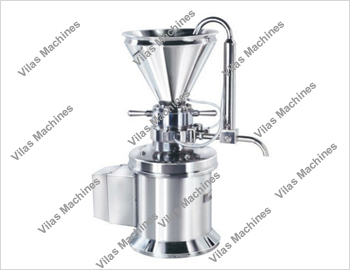COLLOID MILL A colloid mill is a machine used to reduce the particle size of a solid in a liquid suspension or to reduce the droplet size in emulsions. It achieves this by applying mechanical shear and friction forces generated between a rotor and a stator, both of which have highly complex surfaces. The main components of a colloid mill include:
- 1.Rotor: The rotor is a rotating component typically located in the center of the colloid mill. It may have teeth, blades, or other configurations designed to generate shear forces.
- 2.Stator: The stator is the stationary component that surrounds the rotor. It usually has a complex surface with grooves or channels. The gap between the rotor and stator is adjustable, allowing control over the size of the particles or droplets produced.
- 3.Hopper or Feeding Mechanism: The colloid mill is typically equipped with a hopper or another feeding mechanism to introduce the solid material or liquid into the milling chamber.
- 4.Motor: The machine is powered by an electric motor that drives the rotor, creating the necessary mechanical forces for particle or droplet size reduction.
- 5.Adjustment Mechanism: Colloid mills often have an adjustment mechanism to control the gap between the rotor and stator. This gap adjustment allows for fine-tuning the size of the particles or droplets produced.
- 6.Cooling / Heating System: In some applications, especially where temperature control is crucial, colloid mills may have a cooling or heating system to regulate the temperature of the product during the milling process.
- 7. Base or Frame: The entire colloid mill is typically mounted on a sturdy base or frame for stability and support.
Colloid mills are commonly used in the food, pharmaceutical, cosmetic, and chemical industries for processes such as homogenization, emulsification, dispersion, and particle size reduction. The design and specifications of colloid mills can vary based on the specific application and industry requirements.

